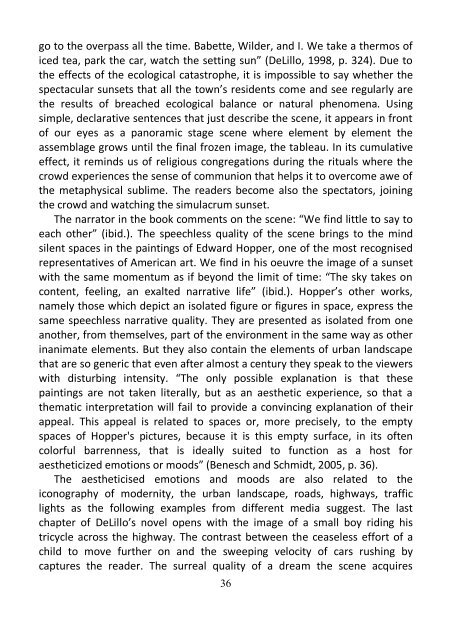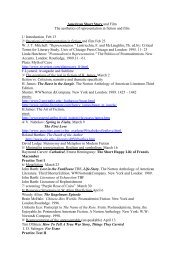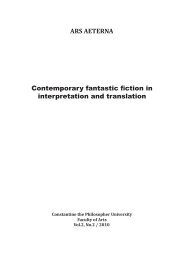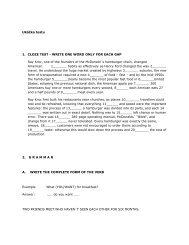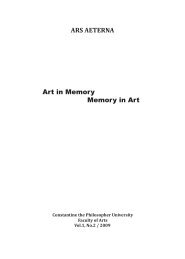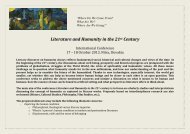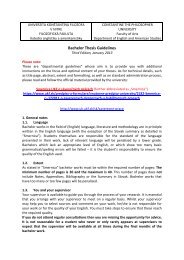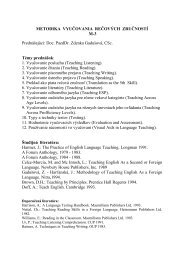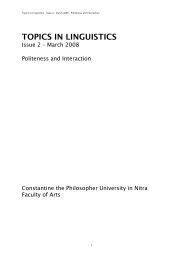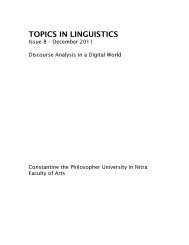Literature and Culture
Literature and Culture
Literature and Culture
You also want an ePaper? Increase the reach of your titles
YUMPU automatically turns print PDFs into web optimized ePapers that Google loves.
go to the overpass all the time. Babette, Wilder, <strong>and</strong> I. We take a thermos of<br />
iced tea, park the car, watch the setting sun” (DeLillo, 1998, p. 324). Due to<br />
the effects of the ecological catastrophe, it is impossible to say whether the<br />
spectacular sunsets that all the town’s residents come <strong>and</strong> see regularly are<br />
the results of breached ecological balance or natural phenomena. Using<br />
simple, declarative sentences that just describe the scene, it appears in front<br />
of our eyes as a panoramic stage scene where element by element the<br />
assemblage grows until the final frozen image, the tableau. In its cumulative<br />
effect, it reminds us of religious congregations during the rituals where the<br />
crowd experiences the sense of communion that helps it to overcome awe of<br />
the metaphysical sublime. The readers become also the spectators, joining<br />
the crowd <strong>and</strong> watching the simulacrum sunset.<br />
The narrator in the book comments on the scene: “We find little to say to<br />
each other” (ibid.). The speechless quality of the scene brings to the mind<br />
silent spaces in the paintings of Edward Hopper, one of the most recognised<br />
representatives of American art. We find in his oeuvre the image of a sunset<br />
with the same momentum as if beyond the limit of time: “The sky takes on<br />
content, feeling, an exalted narrative life” (ibid.). Hopper’s other works,<br />
namely those which depict an isolated figure or figures in space, express the<br />
same speechless narrative quality. They are presented as isolated from one<br />
another, from themselves, part of the environment in the same way as other<br />
inanimate elements. But they also contain the elements of urban l<strong>and</strong>scape<br />
that are so generic that even after almost a century they speak to the viewers<br />
with disturbing intensity. “The only possible explanation is that these<br />
paintings are not taken literally, but as an aesthetic experience, so that a<br />
thematic interpretation will fail to provide a convincing explanation of their<br />
appeal. This appeal is related to spaces or, more precisely, to the empty<br />
spaces of Hopper's pictures, because it is this empty surface, in its often<br />
colorful barrenness, that is ideally suited to function as a host for<br />
aestheticized emotions or moods” (Benesch <strong>and</strong> Schmidt, 2005, p. 36).<br />
The aestheticised emotions <strong>and</strong> moods are also related to the<br />
iconography of modernity, the urban l<strong>and</strong>scape, roads, highways, traffic<br />
lights as the following examples from different media suggest. The last<br />
chapter of DeLillo’s novel opens with the image of a small boy riding his<br />
tricycle across the highway. The contrast between the ceaseless effort of a<br />
child to move further on <strong>and</strong> the sweeping velocity of cars rushing by<br />
captures the reader. The surreal quality of a dream the scene acquires<br />
36


